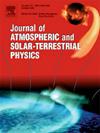Mapping of flood inundated areas using earth observation data and cloud computing platform
IF 1.9
4区 地球科学
Q3 GEOCHEMISTRY & GEOPHYSICS
Journal of Atmospheric and Solar-Terrestrial Physics
Pub Date : 2025-06-13
DOI:10.1016/j.jastp.2025.106567
引用次数: 0
Abstract
Floods pose a significant threat, not only impacting human lives and property, but also causing extensive damage to critical infrastructure. Rapid flood impact assessment methods require comprehensive, updated and accurate flood maps to deliver the dependable information for effective disaster risk management. In this study, the flood-inundated areas were mapped and monitored in Punjab (India) using dual-polarized (VH and VV) Sentinel-1 (A and B) images of July–August 2023 and the impact of flood on cropped area was assessed using Geographic Information System (GIS). The satellite images were processed in Google Earth Engine (GEE) platform to extract the spatial extent of flood-inundated areas. The flooded areas were validated with limited ground truth. The district wise zonal statistics was derived to find the flood inundated areas. Results showed that the backscattering coefficient (σ0) of the flooded area ranged from −4 to −20 dB for VH polarization and from −4 to −30 dB for VV polarization. These threshold limits were used to extract the flood pixels followed by masking of permanent water bodies. The water extent reached its peak from 11 to July 17, 2023 (first flood period) and again from 14 to August 17, 2023 (Second flood period) in Punjab with 5.52 % of the area inundated during first flood period and 2.65 % of the cropped area inundated during the second flood period. The overall accuracy was 91.7 % with Kappa Coefficient of 0.83 in VV polarization and 86.2 % with Kappa Coefficient of 0.73 in VH polarization. Paddy was mostly inundated by flooding in the areas with lower elevation, high runoff and along the river breeches. These results suggest that spatio-temporal mapping of flood inundation is important for policy makers towards flood risk preparedness, raising awareness, designing the mitigation strategies and implementation of flood management planning to protect nature and human life.
利用对地观测数据和云计算平台绘制洪水淹没地区图
洪水构成重大威胁,不仅影响人类生命和财产,而且对关键基础设施造成广泛破坏。快速洪水影响评估方法需要全面、更新和准确的洪水地图,为有效的灾害风险管理提供可靠的信息。本研究利用2023年7 - 8月的双极化(VH和VV) Sentinel-1 (A和B)图像对印度旁遮普省的洪水淹没区域进行了测绘和监测,并利用地理信息系统(GIS)评估了洪水对农作物面积的影响。利用谷歌Earth Engine (GEE)平台对卫星图像进行处理,提取洪水淹没区域的空间范围。洪水泛滥的地区用有限的地面真实情况进行了验证。通过区域统计和分区统计,找到了洪水淹没区域。结果表明:淹没区的后向散射系数(σ0)在VH极化为−4 ~−20 dB, VV极化为−4 ~−30 dB;使用这些阈值限制提取洪水像素,然后对永久水体进行掩模。旁遮普省在2023年第一次洪涝期(11 - 7月17日)和第二次洪涝期(14 - 8月17日)分别达到洪涝期(5.52%)和第二次洪涝期(2.65%)的洪涝面积最大。VV偏振的Kappa系数为0.83,整体精度为91.7%;VH偏振的Kappa系数为0.73,整体精度为86.2%。水稻主要被洪水淹没在海拔较低、径流量大的地区和沿河流域。这些结果表明,洪水淹没的时空映射对于决策者在洪水风险防范、提高认识、设计减灾策略和实施洪水管理规划以保护自然和人类生命方面具有重要意义。
本文章由计算机程序翻译,如有差异,请以英文原文为准。
求助全文
约1分钟内获得全文
求助全文
来源期刊

Journal of Atmospheric and Solar-Terrestrial Physics
地学-地球化学与地球物理
CiteScore
4.10
自引率
5.30%
发文量
95
审稿时长
6 months
期刊介绍:
The Journal of Atmospheric and Solar-Terrestrial Physics (JASTP) is an international journal concerned with the inter-disciplinary science of the Earth''s atmospheric and space environment, especially the highly varied and highly variable physical phenomena that occur in this natural laboratory and the processes that couple them.
The journal covers the physical processes operating in the troposphere, stratosphere, mesosphere, thermosphere, ionosphere, magnetosphere, the Sun, interplanetary medium, and heliosphere. Phenomena occurring in other "spheres", solar influences on climate, and supporting laboratory measurements are also considered. The journal deals especially with the coupling between the different regions.
Solar flares, coronal mass ejections, and other energetic events on the Sun create interesting and important perturbations in the near-Earth space environment. The physics of such "space weather" is central to the Journal of Atmospheric and Solar-Terrestrial Physics and the journal welcomes papers that lead in the direction of a predictive understanding of the coupled system. Regarding the upper atmosphere, the subjects of aeronomy, geomagnetism and geoelectricity, auroral phenomena, radio wave propagation, and plasma instabilities, are examples within the broad field of solar-terrestrial physics which emphasise the energy exchange between the solar wind, the magnetospheric and ionospheric plasmas, and the neutral gas. In the lower atmosphere, topics covered range from mesoscale to global scale dynamics, to atmospheric electricity, lightning and its effects, and to anthropogenic changes.
 求助内容:
求助内容: 应助结果提醒方式:
应助结果提醒方式:


